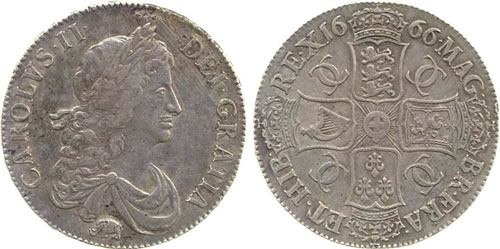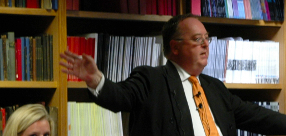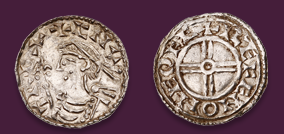
Auction: 3024 - The Slaney Collection of English Coins
Lot: 136
Charles II, Pattern Crown, 33.09g., 1663, the "Petition" Crown, by Thomas Simon, large laureate and draped bust of fine style facing right, struck in high relief, Simon in script below, carolvs ii.dei.gra, toothed border both sides, rev. struck en medaille, crowned cruciform shields, twelve strings to Irish harp, Order of the Garter at centre, pair of interlinked C's in each angle, date either side of crown above English shield, .mag bri.fr et.hib rex. edge, inscribed in two lines in raised letters of an upright axis, thomas simon.most . hvmbly . prays. Yovr Majesty to. compare. this. his .tryall. piece. with. the. dutch. and. if more / trvly. drawn. & emboss' d. more. grace:fvlly. order'd . and . more .accvrately. engraven. to .releive. him. two crowned interlinked C's between branches of palm and laurel at beginning of legend (ESC 72 R4; L&S 6; Bergne, Numismatic Chronicle 1854, p.137), well struck, small die flaw by C at start of legend, with a frosted bust, very attractively toned, one hairline scratch from front lock of hair terminating at edge, tiny dig on reverse between lower left pair of interlinked C's, die flaw by C only very light, otherwise mint state and the finest example of the celebrated Petition Crown available today Estimate £40,000-50,000 provenance
Mrs Morrieson, widow of Lt-Col H W Morrieson, circa 1933
H M Lingford, Glendining, 24 October 1950, lot 268 for £450
It has not been possible to determine the provenance before the ownership of Morriseon. An article by J B Bergne appeared in the Numismatic Chronicle in 1854 (volume XVI), tracing the fifteen then known specimens of the Petition and Reddite Charles II Crowns. From this article we have only managed to deduce which Petition Crown this could not possibly be. The Slaney specimen offered as this lot, has a very distinctive dig in one of the pairs of interlinked C's, which is a good identifying mark on illustrations in previous sales. The dig is obviously of some age and is clearly identifiable on the Lingford plate.
Our suspicions led us to believe that this could have been Bergne specimen number one, or number ten. However, number one is illustrated in the J G Murdoch catalogue of the 8th June 1903, lot 640 and it does not match this coin. The border teeth appear to be quite different as does the flaw by the start of the legend and of course the lack of a dig in the pair of C's.
Specimen number ten in the Bergne article was later owned by and first illustrated in the J E Moon sale of 7-10th May 1901, lot 319, but this piece has a small S shaped scratch running through the crown between the date, and again no dig in the pair of C's.
Of the remaining thirteen specimens, seven are now apparently institutionalised and therefore not available. These are Bergne numbers three, four, five, nine, twelve, thirteen and fifteen.
Of the six specimens left, number two was owned by a Mr John Baker of Islington in 1854, and was later illustrated for the first time when it was sold in the H C Brunning collection on 18 March 1908, lot 23. However the coin offered here does not match the illustration of this piece.
Specimen number six is only in very fine condition and in 1854 it belonged to a Mr W A A White. This is the specimen that was sold in the Rees-Jones collection, Spink Auction 117, lot 117.
Specimen number seven was owned by the distinguished collector J D Cuff in 1854. This specimen has been traced through to the Norweb collection sold at Spink auction 45, lot 223, and later in the J P Storer collection, Spink auction 111, lot 101.
Specimen number eight was traced by Bergne to W Sheppard in 1854 and was described as being in indifferent condition. The specimen Spink sold in the November 1997 Numismatic Circular was thought by deduction to be this coin as it survives in very fine condition so could be described as indifferent.
Specimen number eleven could by deduction, therefore, be the Slaney specimen. At the time of Bergne's article it was described as being "highly preserved" and was owned by Sir George Chetwynd. However this coin did not appear in his sale at Christies in 1872. Though his example of the pewter "Reddite" crown did as lot 426. There was a later sale at Christies on the 12 June 1901, lots 30 and 31 were two coin lots from the Chetwynd family, one being a gold Charles II Crown, but alas no Petition Crown. We have not been able to ascertain where this coin has been since 1854 and have not seen an illustration of it, but the condition sounds similar to the Slaney piece.
Specimen number fourteen was reported as being owned by a Mrs Biscoe but was apparently in very poor condition and is therefore presumably not the coin offered here. Two poor specimens that have appeared at auction in the 20th century have been traced in our quest for the history of the Slaney specimen, one of which is probably the Mrs Biscoe piece. Both have been illustrated, one in the Augustus Thelluson sale of the 19 October 1931, lot 276, and the other in the Thomas Wakley collection, 6-8 December 1909, lot 156. This means that one of these is an extra specimen to those traced by Bergne, making a total of sixteen Petition Crowns.
A seventeenth specimen appeared at auction and was illustrated for the first time in the "Nobleman" sale of 29-30 June 1903, lot 102. This specimen was not available to Bergne as it had been sealed up for safe keeping in 1789. The Nobleman in question was the Marquess of Aylesbury. However this coin has an identifying dig in the middle of the diagonally opposing pair of interlinked C's to the Slaney specimen.
In conclusion we have a provenace back to the ownership of Morrieson, but cannot say for sure where the coin was prior to that collection. It could be the Chetwynd coin but maybe we will never know for sure.
The history behind the manufacture of the coin is even more impressive.
At the time of the Restoration in 1660, the sole Mint engraver was Thomas Simon (1618-65), who was a protege of Edward Greene, apprenticed in 1635. By age twenty in 1638, he was engraving seals for the Admiralty and Privy Council. Due to the skill with which he worked this led to him being employed as Joint-Engraver with Edward Wade at the Tower on 4 April 1645. In April 1649 he was appointed Chief Graver under the Commonwealth regime supplanting Thomas Rawlins, who had left four years previously. Upon the Restoration of the monarchy, Rawlins returned to the position of Chief Graver in July 1660. Simon, though demoted, continued with his contemporary David Ramage (died 1662), in the Mint's employ.
In early 1661 the King gave orders for the instruments and tools of Nicholas Briot and Pierre Blondeau that struck much of the Commonwealth coinage to be delivered to the Master of the Edinburgh Mint, Sir John Falconer. Thomas Simon was sent to France on an order of May 17 to obtain the services of Blondeau and his new machinery as "all monies both of Gold and Silver should be made by way of the Screw and Press." In September a proclamation was enacted to call in all the coinage used under the Commonwealth. The response was initially very slow and the time limit for recall was lengthened until the 28 February 1661/2. Meanwhile Blondeau arrived in England with his machinery and tools, while Simon was issued with orders on the 31 January and 3 February 1661/2 "to make stamps for the new Coyne". The first coins to be produced being some 3,000 gold broads.
With the anticipated mintage of new coinage, other engravers were brought in to assist in the process of making dies. The King, while in exile, had received monetary assistance from Philip Roettier of Antwerp, whose two elder sons were skilled in the art of engraving. John (c.1631-1700) and Joseph (1635-1703), duly arrived in London on the invitation of the King and so the scene was set for the "competition" to determine who should make the new dies to be used on the new technology. An order of the 7 Febraury 1661/2 dictated:
"Whereas Wee have given order to Tho. Symon one of Our Chiefe Gravers and also to John and Joseph Roettiers Gravers to make the Stamps for Our Moneys by way of the Presse Our Will and Pleasure is that they severally first make a triall piece of 5 Shillings in Silver according to Each other draughts of head and arms shewed unto Us with all convenient speed that may bee and that noe persons be suffered to disturb or oversee their worke untill ye same shalbe perfected and presented to Us for Our Judgment therein".
As a model to work from the artists were given a new portrait of the King by Samuel Cooper (1609-72). The diarist John Evelyn, records that he held the candle while Cooper "was crayoning...the King's face and head, to make the stamps for the new mill'd money now contriving... he choosing the night and candlelight for ye better finding out the shadows."
Thomas Simon took affront to the arrival of the Roettier brothers, and acute friction apparently resulted. The "competition" commenced and was eventually decided in favour of John Roettier. As a result on the 19 May 1662 Roettier was commanded to prepare "all the master puncheons, letters and charges for silver and gold coins to be made by mill and press and to make dies for coining according to directions". On the same day, his appointment as one of the chief engravers of the Mint was announced.
The first specimens were not struck until 6 Febraury 1662/3 on Blondeau's new machinery. Samuel Pepys, in his diary for 9 March 1662/3, records: "There dined with us today Mr [Henry] Slingsby [Master] of the Mint, who showed us all the new pieces both gold and silver that are made for the King by Blondeau's way; and compared them with those made for Oliver. The pictures of the latter made by Symons, and of the King by one Royter, a German I think, that dined with us also. He extolls those of Royter's above the others, and indeed, I think they are better, because the sweeter of the two; but, upon my word, those of the Protector are more like to my mind, than the King's, but both very well worth seeing."
A Proclamation on the 27 March 1663 made the new coins current, and it would appear Simon used them as a model for his Petition Crown, so called after the legend engraved on it's edge. Evelyn commented thus:
"For the honour of our countrymen, I cannot here omit that ingenious trial of skill which a commendable emulation has produced in a medal performed with extraordinary accuracy by one who, having been deservedly employed in the Mint at the Tower, was not willing to be supplanted by foreigners."
The appeal was unsuccessful, yet there was other work available for Simon to do. He continued engraving the smaller silver coin dies and produced a new Great Seal of England. Thomas Simon died in 1665 a victim of the Great Plague.
Of Simon's Crown, there are four different varieites of edge, of which this is the most famous, petitioning the King in two lines to compare the competing designs and to relieve the designer of the inferior piece.
The Royal Mint retain the original obverse die for Simon's crown, but it is now in a dilapidated state.
Sold for
£120,000




